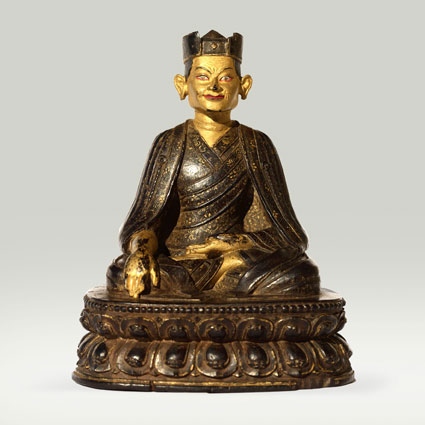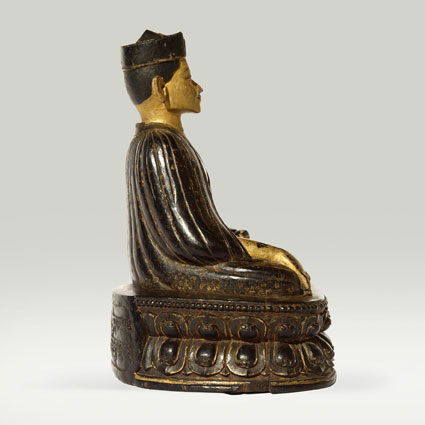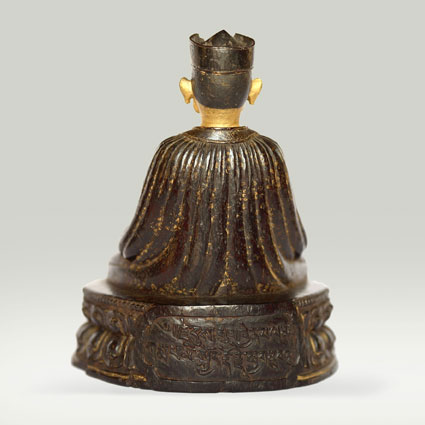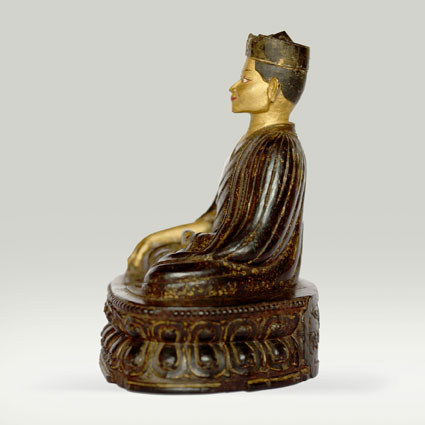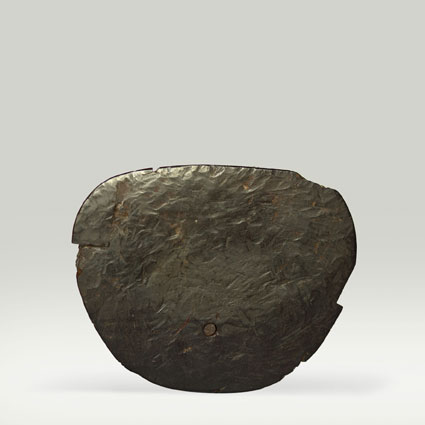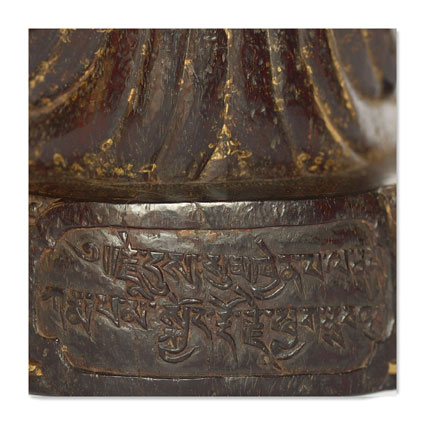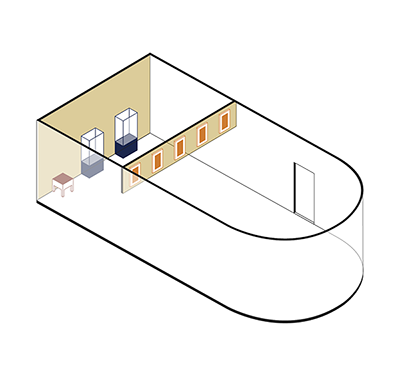ABS 134
Code: ABS 134
Country: Tibet
Style:
Date: 1500 - 1600
Dimensions in cm WxHxD: 12.1 x 14.8 x 9.7
Materials: Painted wood
First Karmapa Dus gsum mkhyen pa
("tüsum khyenpa") (1110-1193)
(Tib. dus gsum mkhyen pa)
Dedicated by Mykyeu Dorge the 8th Karmapa (see inscription)
The bKa’ brgyud («kagyü») order consists of several lineages, most prominent of which is the Dvags po bKa’ brgyud («dagpo kagyü»), as well as several minor schools such as the Shangs pa bKa’ brgyud («shangpa kagyü»). The Karma bKa’ brgyud («karma kagyü») school is one of the four major sub-schools of the Dvags po bKa’ brgyud school, based on the teachings of Dus gsum mkhyen pa (1110–1193) («tüsum khyenpa») the First Zhwa nag («shanag») (“black hat”) Karmapa.
(Tib. dus gsum mkhyen pa)
Dedicated by Mykyeu Dorge the 8th Karmapa (see inscription)
The bKa’ brgyud («kagyü») order consists of several lineages, most prominent of which is the Dvags po bKa’ brgyud («dagpo kagyü»), as well as several minor schools such as the Shangs pa bKa’ brgyud («shangpa kagyü»). The Karma bKa’ brgyud («karma kagyü») school is one of the four major sub-schools of the Dvags po bKa’ brgyud school, based on the teachings of Dus gsum mkhyen pa (1110–1193) («tüsum khyenpa») the First Zhwa nag («shanag») (“black hat”) Karmapa.
Biography
Düsum Khyenpa (1110 - 1193)– The First Karmapa
“In the future, you will be the buddha named Drukpa Sengge, In the present, you nurture all realms through many emanations. Lord of dharma, ruler of the teachings of the practice lineage,
Düsum Khyenpa, we supplicate at your feet.” (from Supplication To The Karmapas)
"Knower of the Three Times"
Early Years
Born to a family of devoted Buddhist practitioners in Teshö in eastern Tibet, the boy who was to become known as the first Karmapa was called Gephel as a child. He first studied with his father, and became a knowledgeable and seasoned practitioner, even as a young child. He continued his education with other Buddhist teachers of the region. First Teachers
Already quite learned by the age of twenty, he moved to Central Tibet, became a monk and spent the next twelve years or so engaging in study and meditation practices. He studied with very well-known masters of the time, such as Chapa Chokyi Senge (1109-1169), a great logician and the founder of the debate system in Tibet, and Patsab Lotsawa Nyima Drakpa (1055-?), who translated many madhyamaka texts (one of the highest schools of Buddhist philosophy) into Tibetan and was a great master of the Prasangika Madhyamaka tradition.
Training under Gampopa
At the age of thirty, he received teachings from Gampopa, the heart son of the greatest yogi in Tibetan history, Milarepa. Düsum Khyenpa first trained in the foundation practices of the Khadampa tradition and, following that, in the general philosophy of the sutras. This training in the basis of all Buddhist traditions established a pattern for all future Kagyu followers by demonstrating the importance of establishing a correct basis of knowledge. This is true even when engaging in the most powerful of advanced vajrayana practices. Düsum Khyenpa also received and unified the lineage teachings he received from Rechungpa and other students of Milarepa.
The Karmapa's accomplishment in meditation and the practices transmitted to him by his teachers were greatly enhanced by his own natural compassion. His practice produced rapid results and great accomplishments, or siddhis. Such accomplishment is often perceived by followers as the ability to perform miraculous activity and in fact, the legends of the Karmapas through the ages speak of their ability, through the manifestation of this seemingly miraculous activity, to create a great sense of wonder and faith in their students. All the Karmapas have since been known for their ability to inspire, through their simple presence, this profound sense of wonder and faith in the reality of the accomplishment which is the fruition of the Buddhist path.
Establishing Monastic Seats
At the age of 55 (1164), Düsum Khyenpa founded a monastery at Kampo Nénang; and at the age of 60 (1169), he started the Panphuk monastery in Lithang, in East Tibet. Later, at the age of 76 (1185), he established an important seat at Karma Gön, in eastern Tibet (1184). At the age of 80 (1189), he established his main seat at Tsurphu, in the Tolung valley, a river which feeds into the Brahmaputra, in central Tibet.
The first Karmapa, Düsum Khyenpa, made predictions about future Karmapas. In particular, he was the first Karmapa to present a prediction letter, detailing his future incarnation. He gave it to his main disciple, Drogon Rechen, whom he chose to become the next lineage-holder.
Düsum Khyenpa passed away at the age of eighty-four. Among his other main disciples were Tak-lungpa, founder of the Ta-lung Kagyu, Tsangpa Gyare, founder of the Drukpa Kagyu, and Lama Khadampa Deshek, founder of the Katok Nyingma lineage.
The principal student who held the lineage of the Golden Rosary from the First Karmapa was Drogon Rechen.
Drogon Rechen (1148-1218)
Drogon Rechen was born to an educated family in the Yarlung area of Tsang, part of Central Tibet. As a young child, he demonstrated his awakened potential in the gradual path of hinayana-mahayana. At the age of nine, he connected to the Kagyu master, Zangri Repa, and received many teachings, including ear-whispered teachings and dohas of the Mahamudra masters. He practiced meditation wearing only a cotton cloth and was therefore called "Rechen," which means "great cotton-clad yogi." He experienced many signs of meditative accomplishment.
Studying In Milarepa's Tradition
When he reached the age of fifteen, his teacher, Zangri Repa, passed into parinirvana. Before his passing away, Drogon Rechen was advised to find the disciples of Milarepa's lineage, receive the full lineage transmission, and practice hard so that he could become a great master in this tradition. In accordance with this, he studied and practiced under many Kagyu masters as well as with Dzogchen masters. Although he attained great qualities of samadhi he still was not fully satisfied. Deciding to leave his home to develop his practice further, he started a journey to Kham, in eastern Tibet, through Kongpo. On his way, he met and received many teachings - from Thöpa Samdrup, he received the complete transmission of the Chöd lineage; from Ngari-pa, he received Vajrapani and Vajrasaddhu; from Nyalpa Josey, he received Peaceful and Wrathful Manjushri and Mahakala. He established eighteen Tantric seats and many great practitioners have been produced as a result.
Meeting The First Karmapa
Drogön Rechen mastered the prana and nadhi practices at this point, and a little bit of pride in his accomplishment developed. Upon hearing the fame of the First Karmapa Düsum Khyenpa, who was living at Kampo Nenang, Drogön Rechen decided to meet him. He simply wished to pay Düsum Khyenpa his respects but had no intention of studying with the Karmapa. The First Karmapa told Drogon Rechen, when they first met, "O young tantric practitioner, you can go and study with my students." Drogön Rechen asked "what kind of students do you have?" Karmapa replied "Deuchung Sangye, Baltsa Takdelwa, and so on." Drogon Rechen first went to see Deuchung Sangye who directed him to Baltsa Takdelwa. When he went to the cave of Takdelwa, he saw a huge tiger sleeping there and he ran back with great fear. Deuchung told him to go back again and when he did, he saw a little pond in the cave. He circumambulated the water and threw some pebbles in it and left. When he was told to go back and went, he saw an old yogi who had those pebbles he threw on his lap.
At that time, he thought "if the students are like this, it is unnecessary to point out how great must be their teacher's realization and achievement!" Making a strong commitment, he practiced under their direction for seven years and completely settled his practice and realization. Drogon Rechen became one of the most important heart disciples of the First Karmapa. He was fully ordained as a monastic at the age of thirty-seven and received the name Sönam Drakpa. He received the full Kagyu transmission from the First Karmapa for three more years and became the lineage-holder. When Karmapa traveled back to Central Tibet, Drogön Rechen stayed behind in the Kham region and continued the activities of the Karmapa and the lineage at the seats of Karma Gön and Kampo Nenang. At the age of 70, he passed into parinirvana on the 25th day and many relics arose from the cremation.
His principal disciple and the Kagyu lineage holder was Pomdrakpa Sönam Dorje.
(These details about Drogon Rechen are compiled from Pawo Tsuklak Trengwa's Feast For Scholars (chos 'byung mkhas pa'i dg'a ston), Beijing edition, vol. 2, pp. 873-877).
Pomdrakpa (1170 - 1249)
Pomdrakpa Sonam Dorje was born Dri Dampa Chöchuk in Central Tibet. At the age of five, he started his education, and at the age of nine, he received the mother Tantra transmissions from Nyen Lhakhang Gangpo. When he was fourteen, he heard the fame of the great master, Drogön Rechen. Upon hearing his name, a special meditative experience arose within him and he had a vision of red dakinis who prophesized Drogon Rechen as his teacher. Within ten days, he went to visit Drogön Rechen and received the full monastic ordination and was named Sönam Dorje. From that moment, he followed Drogon Rechen as his principal teacher, from whom he received many abhishekas. He practiced with great diligence for many years. Pomdrakpa had many visions of the wisdom deities during abhishekas and practice sessions, as well as a vision of the First Karmapa who gave him important instructions. From Drogön Rechen, he received the full Kagyu transmission and became the lineage-holder.
Holding The Kagyu Lineage
Pomdrakpa received the full Kagyu teachings, and became a gifted master. Before the passing away, Drogon Rechen told Pomdrakpa and Lodrö Rinchen that they were the masters of the teachings, who could each hold this lineage. He also predicted that Pomdrakpa's activities would flourish, and the lineage would prosper even more during the time of his disciples and afterwards in the future. During that time, Pomdrakpa saw his teacher as the Buddha Shakyamuni surrounded by countless buddhas. This is said to be the auspicious sign of becoming the main lineage holder.
Pomdrakpa Sönam Dorje's activities of benefiting beings flourished as predicted, and he passed on the lineage transmission to the Second Karmapa, Karma Pakshi.
Düsum Khyenpa (1110 - 1193)– The First Karmapa
“In the future, you will be the buddha named Drukpa Sengge, In the present, you nurture all realms through many emanations. Lord of dharma, ruler of the teachings of the practice lineage,
Düsum Khyenpa, we supplicate at your feet.” (from Supplication To The Karmapas)
"Knower of the Three Times"
Early Years
Born to a family of devoted Buddhist practitioners in Teshö in eastern Tibet, the boy who was to become known as the first Karmapa was called Gephel as a child. He first studied with his father, and became a knowledgeable and seasoned practitioner, even as a young child. He continued his education with other Buddhist teachers of the region. First Teachers
Already quite learned by the age of twenty, he moved to Central Tibet, became a monk and spent the next twelve years or so engaging in study and meditation practices. He studied with very well-known masters of the time, such as Chapa Chokyi Senge (1109-1169), a great logician and the founder of the debate system in Tibet, and Patsab Lotsawa Nyima Drakpa (1055-?), who translated many madhyamaka texts (one of the highest schools of Buddhist philosophy) into Tibetan and was a great master of the Prasangika Madhyamaka tradition.
Training under Gampopa
At the age of thirty, he received teachings from Gampopa, the heart son of the greatest yogi in Tibetan history, Milarepa. Düsum Khyenpa first trained in the foundation practices of the Khadampa tradition and, following that, in the general philosophy of the sutras. This training in the basis of all Buddhist traditions established a pattern for all future Kagyu followers by demonstrating the importance of establishing a correct basis of knowledge. This is true even when engaging in the most powerful of advanced vajrayana practices. Düsum Khyenpa also received and unified the lineage teachings he received from Rechungpa and other students of Milarepa.
The Karmapa's accomplishment in meditation and the practices transmitted to him by his teachers were greatly enhanced by his own natural compassion. His practice produced rapid results and great accomplishments, or siddhis. Such accomplishment is often perceived by followers as the ability to perform miraculous activity and in fact, the legends of the Karmapas through the ages speak of their ability, through the manifestation of this seemingly miraculous activity, to create a great sense of wonder and faith in their students. All the Karmapas have since been known for their ability to inspire, through their simple presence, this profound sense of wonder and faith in the reality of the accomplishment which is the fruition of the Buddhist path.
Establishing Monastic Seats
At the age of 55 (1164), Düsum Khyenpa founded a monastery at Kampo Nénang; and at the age of 60 (1169), he started the Panphuk monastery in Lithang, in East Tibet. Later, at the age of 76 (1185), he established an important seat at Karma Gön, in eastern Tibet (1184). At the age of 80 (1189), he established his main seat at Tsurphu, in the Tolung valley, a river which feeds into the Brahmaputra, in central Tibet.
The first Karmapa, Düsum Khyenpa, made predictions about future Karmapas. In particular, he was the first Karmapa to present a prediction letter, detailing his future incarnation. He gave it to his main disciple, Drogon Rechen, whom he chose to become the next lineage-holder.
Düsum Khyenpa passed away at the age of eighty-four. Among his other main disciples were Tak-lungpa, founder of the Ta-lung Kagyu, Tsangpa Gyare, founder of the Drukpa Kagyu, and Lama Khadampa Deshek, founder of the Katok Nyingma lineage.
The principal student who held the lineage of the Golden Rosary from the First Karmapa was Drogon Rechen.
Drogon Rechen (1148-1218)
Drogon Rechen was born to an educated family in the Yarlung area of Tsang, part of Central Tibet. As a young child, he demonstrated his awakened potential in the gradual path of hinayana-mahayana. At the age of nine, he connected to the Kagyu master, Zangri Repa, and received many teachings, including ear-whispered teachings and dohas of the Mahamudra masters. He practiced meditation wearing only a cotton cloth and was therefore called "Rechen," which means "great cotton-clad yogi." He experienced many signs of meditative accomplishment.
Studying In Milarepa's Tradition
When he reached the age of fifteen, his teacher, Zangri Repa, passed into parinirvana. Before his passing away, Drogon Rechen was advised to find the disciples of Milarepa's lineage, receive the full lineage transmission, and practice hard so that he could become a great master in this tradition. In accordance with this, he studied and practiced under many Kagyu masters as well as with Dzogchen masters. Although he attained great qualities of samadhi he still was not fully satisfied. Deciding to leave his home to develop his practice further, he started a journey to Kham, in eastern Tibet, through Kongpo. On his way, he met and received many teachings - from Thöpa Samdrup, he received the complete transmission of the Chöd lineage; from Ngari-pa, he received Vajrapani and Vajrasaddhu; from Nyalpa Josey, he received Peaceful and Wrathful Manjushri and Mahakala. He established eighteen Tantric seats and many great practitioners have been produced as a result.
Meeting The First Karmapa
Drogön Rechen mastered the prana and nadhi practices at this point, and a little bit of pride in his accomplishment developed. Upon hearing the fame of the First Karmapa Düsum Khyenpa, who was living at Kampo Nenang, Drogön Rechen decided to meet him. He simply wished to pay Düsum Khyenpa his respects but had no intention of studying with the Karmapa. The First Karmapa told Drogon Rechen, when they first met, "O young tantric practitioner, you can go and study with my students." Drogön Rechen asked "what kind of students do you have?" Karmapa replied "Deuchung Sangye, Baltsa Takdelwa, and so on." Drogon Rechen first went to see Deuchung Sangye who directed him to Baltsa Takdelwa. When he went to the cave of Takdelwa, he saw a huge tiger sleeping there and he ran back with great fear. Deuchung told him to go back again and when he did, he saw a little pond in the cave. He circumambulated the water and threw some pebbles in it and left. When he was told to go back and went, he saw an old yogi who had those pebbles he threw on his lap.
At that time, he thought "if the students are like this, it is unnecessary to point out how great must be their teacher's realization and achievement!" Making a strong commitment, he practiced under their direction for seven years and completely settled his practice and realization. Drogon Rechen became one of the most important heart disciples of the First Karmapa. He was fully ordained as a monastic at the age of thirty-seven and received the name Sönam Drakpa. He received the full Kagyu transmission from the First Karmapa for three more years and became the lineage-holder. When Karmapa traveled back to Central Tibet, Drogön Rechen stayed behind in the Kham region and continued the activities of the Karmapa and the lineage at the seats of Karma Gön and Kampo Nenang. At the age of 70, he passed into parinirvana on the 25th day and many relics arose from the cremation.
His principal disciple and the Kagyu lineage holder was Pomdrakpa Sönam Dorje.
(These details about Drogon Rechen are compiled from Pawo Tsuklak Trengwa's Feast For Scholars (chos 'byung mkhas pa'i dg'a ston), Beijing edition, vol. 2, pp. 873-877).
Pomdrakpa (1170 - 1249)
Pomdrakpa Sonam Dorje was born Dri Dampa Chöchuk in Central Tibet. At the age of five, he started his education, and at the age of nine, he received the mother Tantra transmissions from Nyen Lhakhang Gangpo. When he was fourteen, he heard the fame of the great master, Drogön Rechen. Upon hearing his name, a special meditative experience arose within him and he had a vision of red dakinis who prophesized Drogon Rechen as his teacher. Within ten days, he went to visit Drogön Rechen and received the full monastic ordination and was named Sönam Dorje. From that moment, he followed Drogon Rechen as his principal teacher, from whom he received many abhishekas. He practiced with great diligence for many years. Pomdrakpa had many visions of the wisdom deities during abhishekas and practice sessions, as well as a vision of the First Karmapa who gave him important instructions. From Drogön Rechen, he received the full Kagyu transmission and became the lineage-holder.
Holding The Kagyu Lineage
Pomdrakpa received the full Kagyu teachings, and became a gifted master. Before the passing away, Drogon Rechen told Pomdrakpa and Lodrö Rinchen that they were the masters of the teachings, who could each hold this lineage. He also predicted that Pomdrakpa's activities would flourish, and the lineage would prosper even more during the time of his disciples and afterwards in the future. During that time, Pomdrakpa saw his teacher as the Buddha Shakyamuni surrounded by countless buddhas. This is said to be the auspicious sign of becoming the main lineage holder.
Pomdrakpa Sönam Dorje's activities of benefiting beings flourished as predicted, and he passed on the lineage transmission to the Second Karmapa, Karma Pakshi.
Bock, Etienne; Falcombello, Jean-Marc; Jenny Magali, 2022. Trésors du Tibet. Sur les pas de Milarépa.. Paris: Flammarion. P: 258

